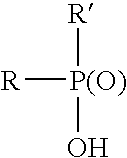Stabilizing aqueous anionic resinous dispersions with chelating agents
a technology of anionic resin and chelating agent, applied in the field of aqueous anionic dispersions, can solve problems such as unstable dispersions
- Summary
- Abstract
- Description
- Claims
- Application Information
AI Technical Summary
Benefits of technology
Problems solved by technology
Method used
Image
Examples
example 1 (
Control)
Anionic Resinous Dispersion With No Chelating Agent
[0037]A mixture of 824.2 parts of bisphenol A diglycidyl ether (EEW 188), 265.1 parts of bisphenol A, and 210.7 parts of 2-n-butoxy-1-ethanol was heated to 115° C. At that point, 0.8 parts of ethyl triphenylphosphonium iodide was added. This mixture was heated and held at a temperature of at least 165° C. for one hour. As the mixture was allowed to cool to 88° C., 51.6 parts of Ektasolve EEH solvent (available from Eastman Chemical Company) and 23.4 parts of 2-n-butoxy-1-ethanol were added. At 88° C., 39.2 parts of 85% o-phosphoric acid and 6.9 parts of Ektasolve EEH were added, and the reaction mixture was subsequently maintained at a temperature of at least 120° C. for 30 min. At that point, the mixture was cooled to 100° C. and 72.0 parts of deionized water was introduced gradually. Once the water addition was completed, a temperature of about 100° C. was maintained for 2 hours. Then the mixture was cooled to 90° C. and 9...
example 2
Anionic Resinous Dispersion with 0.36% EDTA
[0038]A mixture of 792.6 parts of bisphenol A diglycidyl ether (EEW 188), 254.9 parts of bisphenol A, and 202.6 parts of 2-n-butoxy-1-ethanol was heated to 115° C. At that point, 0.8 parts of ethyl triphenylphosphonium iodide was added. This mixture was heated and held at a temperature of at least 165° C. for one hour. As the mixture was allowed to cool to 88° C., 49.6 parts of Ektasolve EEH solvent and 22.5 parts of 2-n-butoxy-1-ethanol were added. At 88° C., 37.7 parts of 85% o-phosphoric acid and 6.6 parts of Ektasolve EEH were added, and the reaction mixture was subsequently maintained at a temperature of at least 120° C. for 30 min. At that point, the mixture was cooled to 100° C. and 69.2 parts of deionized water was introduced gradually. Once the water addition was completed, a temperature of about 100° C. was maintained for 2 hours. Then the mixture was cooled to 90° C. and 87.1 parts of diisopropanolamine was added, followed by a m...
example 3
Aqueous Resinous Dispersion with 0.73% EDTA
[0039]A mixture of 792.6 parts of bisphenol A diglycidyl ether (EEW 188), 254.9 parts of bisphenol A, and 202.6 parts of 2-n-butoxy-1-ethanol was heated to 115° C. At that point, 0.8 parts of ethyl triphenylphosphonium iodide was added. This mixture was heated and held at a temperature of at least 165° C. for one hour. As the mixture was allowed to cool to 88° C., 49.6 parts of Ektasolve EEH solvent and 22.5 parts of 2-n-butoxy-1-ethanol were added. At 88° C., 37.7 parts of 85% o-phosphoric acid and 6.6 parts of Ektasolve EEH were added, and the reaction mixture was subsequently maintained at a temperature of at least 120° C. for 30 min. At that point, the mixture was cooled to 100° C. and 69.2 parts of deionized water was introduced gradually. Once the water addition was completed, a temperature of about 100° C. was maintained for 2 hours. Then the mixture was cooled to 90° C. and 87.1 parts of diisopropanolamine was added, followed by a m...
PUM
| Property | Measurement | Unit |
|---|---|---|
| Percent by mass | aaaaa | aaaaa |
| Percent by mass | aaaaa | aaaaa |
| Percent by mass | aaaaa | aaaaa |
Abstract
Description
Claims
Application Information
 Login to View More
Login to View More - R&D
- Intellectual Property
- Life Sciences
- Materials
- Tech Scout
- Unparalleled Data Quality
- Higher Quality Content
- 60% Fewer Hallucinations
Browse by: Latest US Patents, China's latest patents, Technical Efficacy Thesaurus, Application Domain, Technology Topic, Popular Technical Reports.
© 2025 PatSnap. All rights reserved.Legal|Privacy policy|Modern Slavery Act Transparency Statement|Sitemap|About US| Contact US: help@patsnap.com


